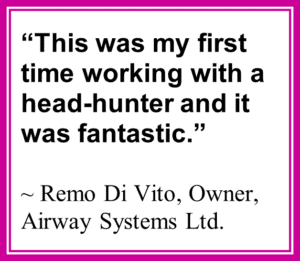(Reading Time: 8 minutes)
Avoid these mistakes and hire the right people for your business so you have more free time…and more peace of mind.
Several years ago, I got a call from a person who wanted my help. After the usual introductions, he got straight to the point.
“I can’t go moose hunting,” he said.
My initial response was that, unfortunately, I couldn’t help very much with that. But as we talked more, he explained that he owned a successful electrical contracting business, but he lacked any sort of middle management.
There was no one who could cover for him in the fall when he usually went moose hunting with his friends for two weeks in Northern Ontario. There was simply no one to run the shop; no one to keep on top of sales, no one to manage the employees and make sure they were showing up at the right places at the right time, no one to stay on track with invoicing.
He needed a “mini-me”.
 His problem neatly illustrates one of the three basic elements of business: time, money, and people. Everyone has the same amount of time; different businesses have different financial needs—though I’m referring to cash here—and every business needs people. Not just any people, but the right people, because, as our slogan says, “fit is everything.”
His problem neatly illustrates one of the three basic elements of business: time, money, and people. Everyone has the same amount of time; different businesses have different financial needs—though I’m referring to cash here—and every business needs people. Not just any people, but the right people, because, as our slogan says, “fit is everything.”
This person had focused on building his technical team but hadn’t built a supporting team. That’s where we came in; he needed our help to hire someone to help run the business and avoid making a critical mistake.
A hiring mistake can be very expensive. In fact, the cost of the mistake is typically proportional to the level of the person hired. For example, if you hire a president of a large public mining company and have to let them go six months later, it can take years for the company to recover and get back on track. Employees will be shocked, the shareholders will have a lot of questions, and people will be wondering what the heck is going on. It can be like a wide crater that needs to be filled.
Where can you go wrong in the hiring process? At Kathbern, we’ve identified 10 common mistakes to avoid.
Mistake 1: Ignoring internal growth potential
The best place to hire from is within your own organization. These are people who already fit your culture and values, know the business, and have some history with the company.
Ideally, you would hire someone at a junior level, and then help them develop so they will be able to grow into more senior positions. You want to make sure they are getting the right training, building the appropriate experience, and receiving coaching that will help them develop into key leaders and decision-makers.
A lot of the time, though, particularly if a company is growing quickly, this doesn’t happen fast enough and there aren’t enough people to fill all the open positions. Then you must hire from outside the organization.
Mistake 2: Under-sizing the job
This is a corollary to the first mistake, not growing your own people.
When you hire somebody, you want to hire someone that can do the immediate job, but also someone who shows the potential to grow into a more senior position in the future. A mistake we see a lot, particularly at growing companies, is hiring someone that will only ever be able to do one specific job.
In a growing company, you really want to have people moving through the system. That means that if you hire a senior accountant, they should have the potential to be the accounting supervisor, and perhaps the accounting manager after that. Otherwise, you’re creating several problems for the future.
For example, you hire a senior accountant who’s above a group of junior accountants in the org chart. If that senior accountant can’t be promoted to accounting supervisor when the accounting supervisor moves up to become the accounting manager, then you’re going to have to go outside the organization to find an accounting supervisor.
Plus, you’ve blocked the path for any one of the junior accountants who want to move along a career trajectory of increasingly senior positions at the company. You can’t promote them to senior accountant, so they are stuck. They’ll eventually get frustrated and leave because there is no upward mobility.
Mistake 3: Focusing on the thinnest slice of the market
If you try to fill a position yourself, often you’ll do it by posting an ad on a job site.
The problem with that is that job ads only reach a thin slice of the market, about 14% of potential candidates. These are largely people between jobs who are actively looking for a new job and reviewing job ads every day. They could also include employed people who aren’t happy where they are currently employed and are keeping an eye out for new opportunities.
But you’ll probably overlook two key groups.
The first is those who are currently employed, busy at work and at home, and not paying attention to what else is out there. They are not thrilled with their current situation but have no time to research the alternatives. However, if an opportunity hit them square in the face, they may pay attention to it.
Secondly, you’ve got a group of people who are just not looking at all. They are happy where they are, have no reason to look for an opportunity, and you’ll never reach them through job ads, because they are never looking. They must be reached directly and be pitched on a great opportunity to make them consider making a change.
Mistake 4: Omitting passive candidates
Passive candidates are the group of people I mentioned above who are employed, busy, and open to moving but not actively following job ads. We estimate that this covers approximately 32% of the candidates for any given position, which is a large group to omit.
When we’re involved, we look at all qualified candidates for a role: those who are actively looking, those who are casually looking, those who are passively looking, and even those who aren’t looking at all.
With that last group of people, they might not be interested initially. But we’ll give them a reason to give us a chance. Maybe it’s a better opportunity from a career perspective, maybe there’s more advancement involved. Maybe it’s more money. Maybe, if it’s an on-site work position, it’s closer to home. Any of these three things can interest someone who isn’t looking.
Mistake 5: Avoiding competitors
This is your best source for candidates! People working for your competitors or peers know the industry, your suppliers and service providers, and probably even your business.
They’re the ones you really should be looking at hiring and are so often overlooked, particularly by internal HR departments, who generally simply review responses to job ads.
Mistake 6: No quarterback
Someone needs to be able to take ownership of the hiring process. When there’s no quarterback in the process, it just drifts.
You’ll end up with too many people calling the play—stepping over each other, fumbling leads, and losing sight of the goal.
Candidates are interviewed and forgotten about while people go on vacation or get involved with other projects. Momentum is lost, as are good candidates.
Mistake 7: Not moving quickly
 This is another mistake that we see a lot: not moving quickly enough in the hiring process.
This is another mistake that we see a lot: not moving quickly enough in the hiring process.
You may interview somebody on Monday this week, then discover someone else and interview them on Friday the next week, then a month later interview a third person. By that time, the first person is gone, or you can’t remember what they are like.
It’s a disjointed, inefficient process where good candidates are lost.
Mistake 8: Having a decision-maker do the screening
Both this common mistake and the previous one can be avoided when you have a quarterback.
If you ask the decision-maker with the most knowledge of what the job entails to go through a stack of 100 or more resumes to create a shortlist, you’ll be waiting a long time. They may have the knowledge, but not the time.
You also want to avoid asking the most junior person in HR to complete this task; with their inexperience, they could be missing good candidates because they don’t recognize them as a good fit. Not all good fits are typical.
A quarterback can work with your recruiting firm or HR department to sort through the candidates, decide which ones should make the list for an initial interview, and perhaps even create a shortlist of candidates for the decision-maker to interview.
Mistake 9: Presenting an informal or incomplete offer
When you find the right candidate, make sure to present a formal offer with a deadline for acceptance. Avoid a verbal offer, which just invites the candidate to counter-offer.
We treat offers like they are real estate offers. They are written on formal letterhead, with a signature and deadline. It’s a legal agreement that needs to be countersigned.
We also encourage all our offers to be conditional on references. So even if a candidate signs, it’s still not a done deal. That way if you don’t like what you find when you check the references, you aren’t tied to the offer.
Mistake 10: Neglecting background checks
This is why all our offers are conditional. We need time to do the background checks and return with a report on what former employers, peers, and subordinates have said about the candidate.
We’ve seen near disasters happen when these are neglected. In one case, we had a very attractive candidate for a VP job. The can

didate got along famously with the president of the organization, and it seemed like a perfect fit. Until it came time to do the background checks—this person could provide no superiors as references. He also would not give consent for a criminal background check. Both of these things were red flags, and we had to tell our client to retract their offer.
So, there you have the 10 common hiring mistakes. If you avoid these, you should find the right people for your business, and maybe even get back to moose hunting this fall.
Larry Smith is the founder and president of Kathbern Management, an executive search firm based in Toronto. Kathbern helps companies find the executives and senior managers who not only have the experience and credentials to fulfill their responsibilities, but also have the emotional and “fit” requirements that will enable them to be successful in a particular environment. Kathbern simplifies the process and, through deep research, brings more and better candidates forward than would ever be possible through a do-it-yourself passive advertising campaign.
Learn more at www.kathbern.com, or contact us today for a free consultation about your key person search. Follow us on LinkedIn, Facebook, and Twitter.

